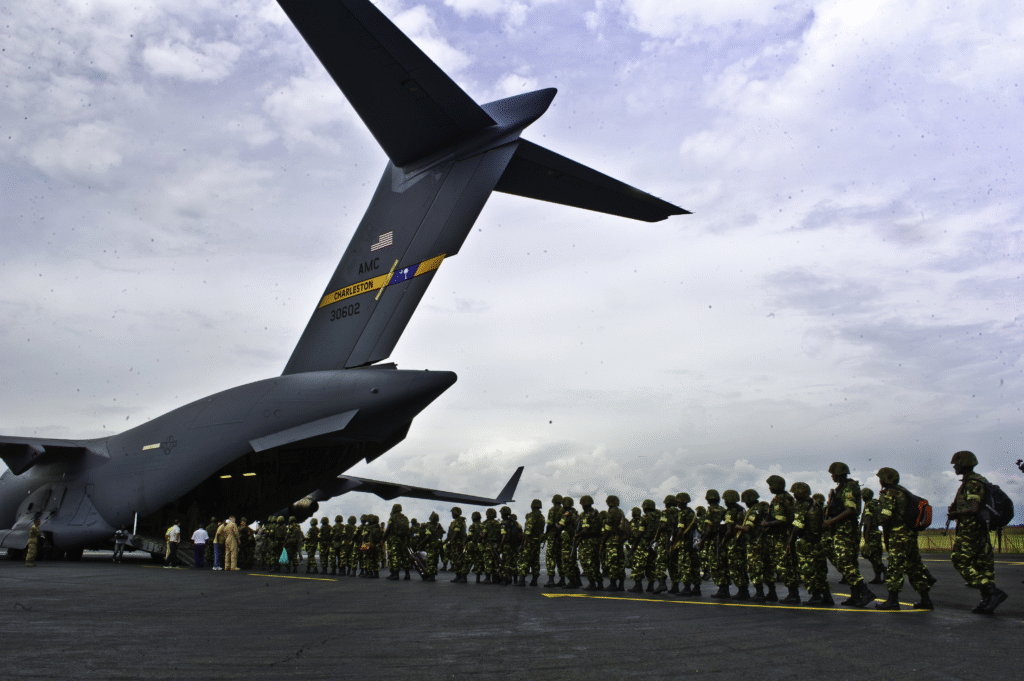Since 2022, Burundi has remained one of the African Union’s principal troop contributors to peace operations—particularly in Somalia under AMISOM and later ATMIS. Although its air force contributions remain limited, available reports and military context offer insight into the broader aviation support during these missions.

◾ Continuity in Somalia Deployments
Burundi has been deploying forces to Somalia since 2007 and remained engaged through AMISOM and into the ATMIS transition (April 2022–December 2024) . With around 5,400 troops at its peak in AMISOM, Burundi operated in key sectors such as Bay, Bakool, and Middle Shabelle .
While direct air force deployments are not officially noted, Burundian forces likely benefited from AU air assets—for example, for logistics, medevac support, or command liaison—given their deployment across remote zones.
◾ Fleet and Aviation Capacity Constraints
Burundi possesses a minimal air combat or utility aviation capability. Reports suggest the country operates only a very small fleet (possibly a single trainer or utility aircraft), and suffers from chronic aviation training gaps . As such, its ability to contribute combat aircraft or helicopters to regional missions remains severely constrained.
Any air support within AU operations where Burundians are deployed would therefore be provided by partner nations, such as Uganda or Kenya, rather than by Burundi’s own air force. Burundi may also rely on AU assets or inter-state logistics arrangements.
◾ Troop Withdrawal from Somalia and Operational Impact
In late December 2024, Burundi announced its withdrawal from the new AUSSOM mission—successor to ATMIS—citing disagreements over troop allocations (the country proposed up to 3,000 personnel but was only allotted ~1,040) . This marked the end of nearly two decades of continuous Burundian participation in Somalia.
Although the announcement does not directly affect aviation support, it underscores Burundi’s declining traction in AU peacekeeping structures—including any coordination with air mobility or logistics assets that had supported its missions.
◾ Shift to DRC under EAC Framework

Following the ATMIS drawdown, Burundi redeployed military forces to eastern DRC—initially as part of the EAC Regional Force in 2023 and subsequently under a bilateral agreement with Kinshasa from mid-2022 onward . While troop deployment involved at least two brigades, air force participation remained negligible.
Given Burundi’s limited aviation infrastructure, any aerial coordination within these operations would be conducted via regional air assets, not directly through its own air wing.
◾ Economic Reliance on Peacekeeping and Air Logistics Role
Peacekeeping missions such as AMISOM/ATMIS represented a vital source of foreign exchange and military financing for Burundi. The government reportedly used allowances and support from troop service abroad to sustain military functioning—and to avoid armed conflict at home .
This financial stake suggests Burundi would have prioritized coordination of logistics—including air transport support for rotations, supplies, and medical evacuations—even if it lacked direct air assets.
◾ Institutional and Training Gaps
Reports indicate that Burundi’s air force operations struggle with constrained pilot training capacity and limited aircraft availability—constraints that typically prevented it from projecting airpower beyond national borders .
As such, while Burundi participated robustly in ground-based peace support operations, its air contribution remained limited to coordination and support via AU-owned or partner-country aviation assets.
◾ AU Peacekeeping Command Integration
During the ATMIS era, command structures in Somalia regularly included Burundian placement, including in deputy force command roles . Though not directly linked to aviation command, such representation suggests Burundian officers participated in mission-wide planning, which would include air-ground coordination and support logistics.
Key Themes in Burundi’s Air Force Support Role
1. Indirect Aviation Participation: Burundi’s contribution to AU missions has not included deployment of aircraft; reliance on external air assets underpins transport, evacuation, and liaison roles.
2. Ground-Focused Contributions: Burundi deployed infantry battalions to Somalia and DRC, but no aircraft — indicating structural limitations in aviation capacity.
3. Training Limitations: Chronic shortages of pilots and aircraft restrict Burundi’s ability to field even a modest air wing for peacekeeping.
4. Financial Dependency: AU peacekeeping deployments provided critical financing for Burundi’s military; air logistics support was a strategic issue in sustaining rotation assets.
5. Command-Level Involvement: Burundian officers held roles in overall mission command that implicitly included coordinating with air force elements of the AU mission structure.


